March 03, 2019
Like fusion cuisine, interior design excels, in my opinion, when cultures and history collide. When I study interiors from some of my favorite designers today - I like to thoughtfully acknowledge the confluences of time periods and artistry that make up these spaces.
It is my belief then, that global and regional influences as well as the centuries of art and design throughout our human history, define interiors today. The most beautiful interiors, through my eyes, are termed eclectic interiors - blending styles and time periods in a thoughtful way where their contrasts keep us spell bound.
Artistically, contrasts create tension and tension is celebrated when it comes to art and design. Mixing smooth and rough, matte and reflective, vertical and horizontal - these are some techniques talented designers use to create breathtaking spaces. In terms of design, my focus at Historic Decorative Materials is the balance between the minimalist decor +.
We all agree we aspire to a home that is a sanctuary of peace and beauty. Often times we feel zen in a minimalist space. This design philosophy uses light and space with minimal details and a limited color palette. However, these interiors may leave one also feeling cold. Combining minimalism with classical interiors can bring together warm + cool, simple + complex that create layers of interest. I do feel best in an uncluttered space that is airy and light, yet I yearn for also simple beauty, texture, color and history. Following an eclectic pairing helps to achieve a space that is not overly designed - but more thoughtfully designed - adding interest that holds the eye and feeds the soul. The road map to achieve the right balance between minimalism + is of course, the materials chosen for the project.
One of the design tenets of minimalism is using fewer materials - but materials that are noble. Nobel materials - like stone and wood - anchor spaces and leave an open canvas upon which one can thoughtfully design.
One of the best examples I can offer you of this design philosophy is from the minimalist Belgian designer Axel Vervoordt. Mr. Vervoordt celebrates minimalism with touches of classicism below by infusing interiors with a sense of history, timelessness, organic materials and extremely fine craftsmanship. In this image where Mr. Vervoordt is standing in his home near Antwerp, notice the hand painted door and trim as well as the sculpture. Both these classical elements marry with a Japanese philosophy that is the elemental beginning of minimalism called wabi-sabi.
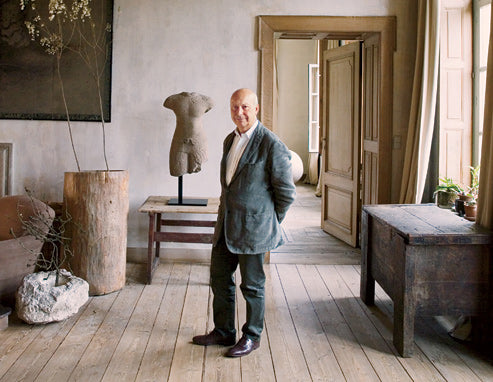
What is wabi-sabi?
Wabi-sabi has its roots in Buddhism where “wabi means simplicity, living in tune with nature and sabi refers to the passage of time; the beauty and authenticity that comes with age.” Referencing Mr. Vervoordt's interior above - one see the wabi-sabi in the geometric forms and irregular surface textures of the planters, the quiet reclaimed wood floor and the antique wooden desk in front of the window. The perfection of imperfection + classical elements feels balanced with beauty, history, color and texture.
This brings me back to a new collection we added to our company - our Master Crafted Hand-Painted Italian Wood Doors. François discovered these doors in Italy last May and he recognized their quality of craftsmanship, their authenticity of materials and their astounding beauty. I knew from a design perceptive how rich in classical tradition these doors were and how beautifully they would combine with a minimalist design philosophy.
In the next image below - I am pairing our Haute Belge Oak Floor, color Andenne with a master crafted hand-painted Italian door, color venezia blu e oro.
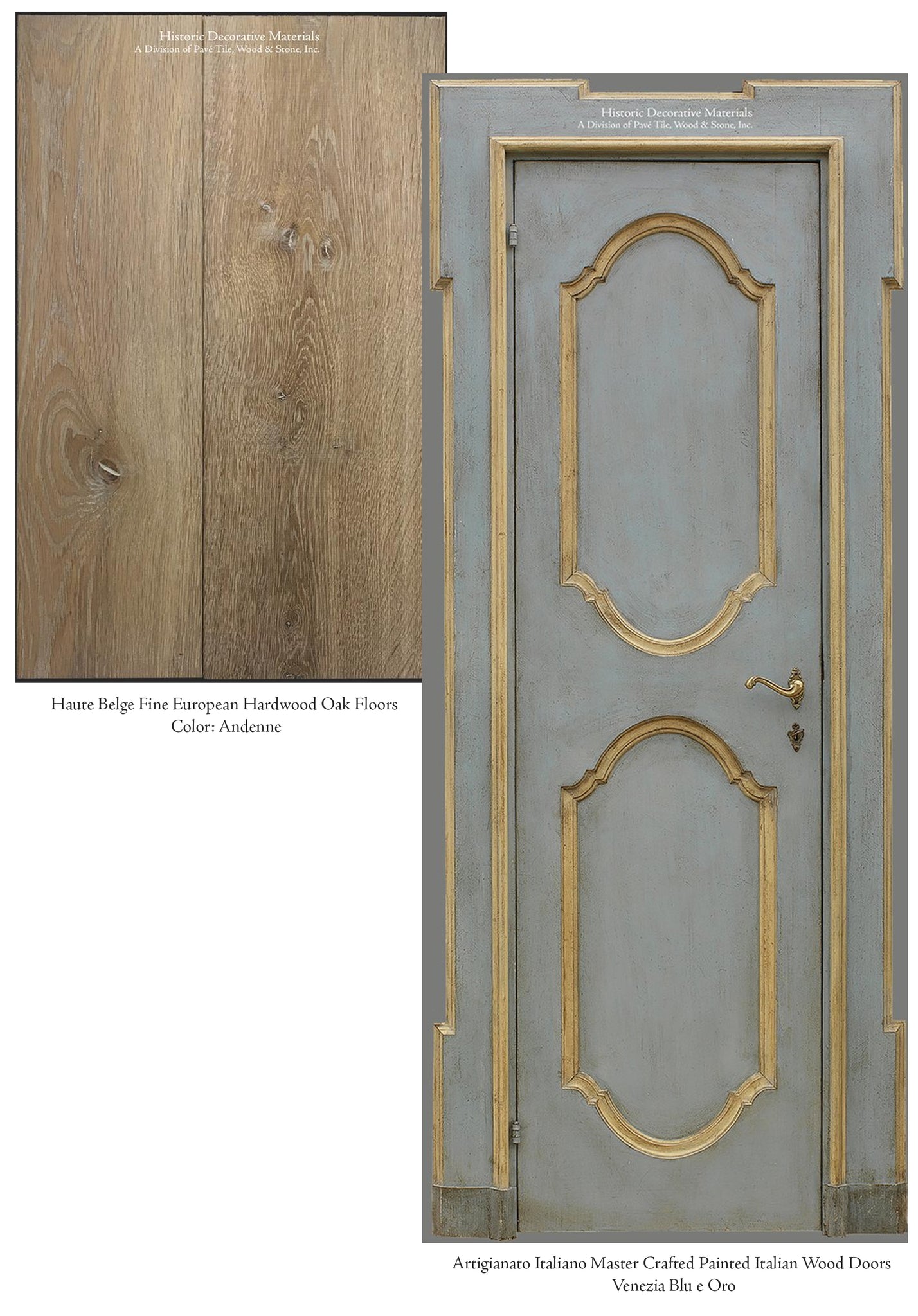
I wonder what Mr. Vervoordt would think of this pairing above? I know he would appreciate the level of fine craftsmanship in both these materials. The key is to allow the quiet Belgian wood floor to anchor the space, while the door remains a mesmerizing haute detail that brings one back to Florence, Italy during the Renaissance. The layers of interest are developed between contrasts of the smooth wood oak floor planes to the artistry of the carved wooden moldings of the door. The hushed quiet of the floor + the joyful curves and colors of the door keep my eye in full circle from floor to door.
Below is another pairing - this time with our Kings of France French Oak Floors, the Great House Collection in Vintage Oak with a master crafted hand-painted Italian wood door in color pietra e grigio. The reclaimed aesthetic of the French oak floor with it's aged oak colors synchronizes with this door's colors. However, the door's classical geometric paneling and edge details provide the juxtaposition to the simplicity of the noble oak floor - and it's this tension that creates the beauty.
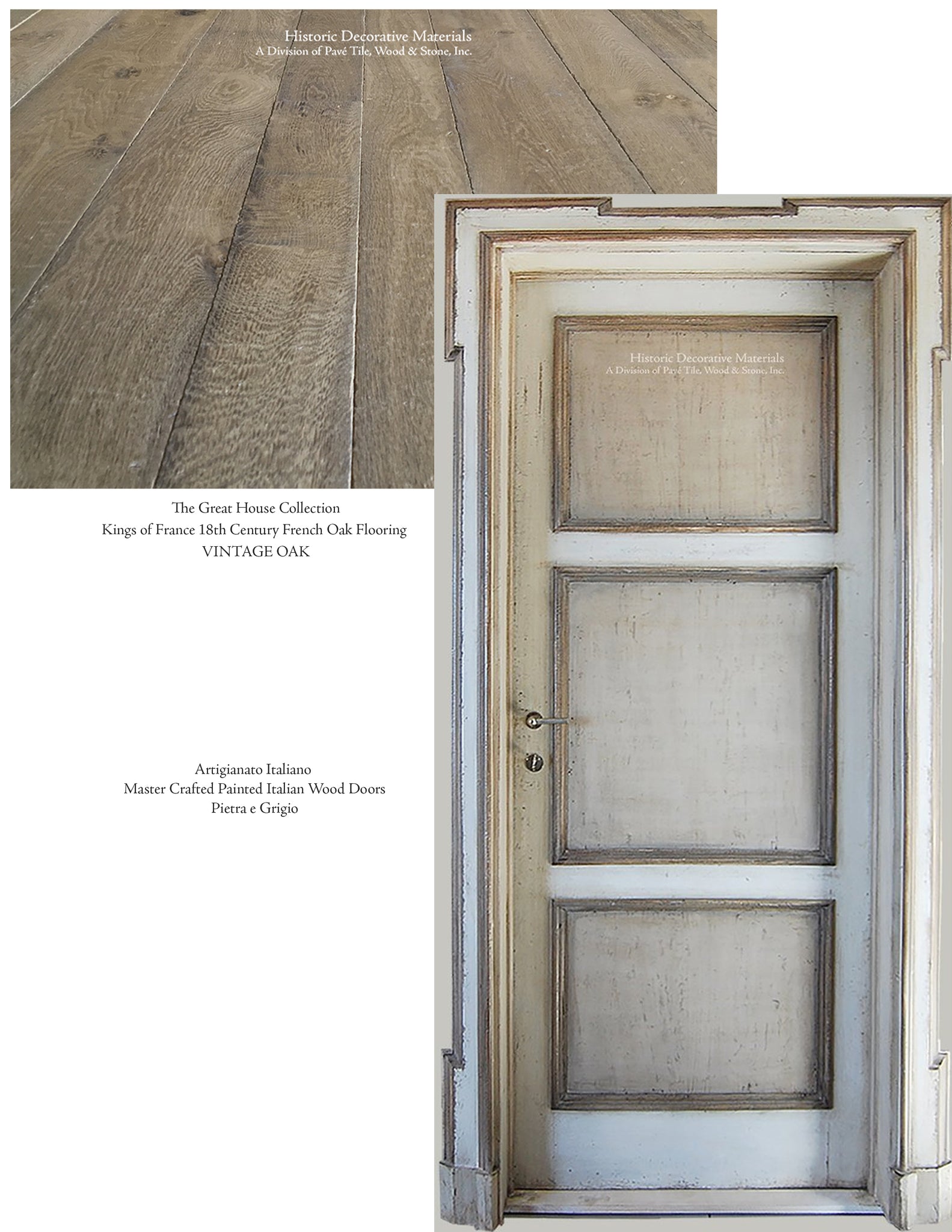
I spoke of noble materials as one of the tenets to minimalism. Not only are these wood flooring collections that I am presenting noble in their serenity and beauty - the nobility is quite apparent in our Master Crafted Hand-Painted Italian Wood Doors as well. They are works of art inspired by Italian antique doors ranging from the 17th-19th centuries. Master Italian wood craftsmen, traditions passed down generations deep, age boards from either poplar or fir that they join following it's natural grain. They assemble each door with special slots or turned nails to minimize or eliminate the use of glues. Artisan locksmiths embellish the hings, handles, lock and key to compliment each door. Hand painted using the Farrow & Ball Colour Palette, these craftsmen then apply aging effects using waxes or lacquers to achieve a surface patina that seems only time could create. Best of all, these doors are pre-hung and include it's jam, trim and hardware ready for installation. Placing these details aside, these hand-crafted doors are breathtaking. Opening one of these doors makes one feel regal in their presence. From their sheer size, solid carriage and antique patina to their architectural molding and custom lock and key hardware - these doors transform a beautiful interior into an unparalleled and magnificent one.
 The freedom we have today of combining aesthetics with an end result of sublime allure should be celebrated. Wabi-sabi and the foundation of minimalism have it's origins dating back to 15th Century Japan. Coincidentally, this was the same time across the globe when the establishment of the Medici Bank and the subsequent trade it generated brought unprecedented wealth to a single Italian city, Florence, Italy. Cosmo de Medici set a new standard for patronage of the arts and turned to Classical themes from the Greeks and Romans to fulfill commissions to decorate the homes of wealthy patrons. Every surface of a home was a canvas to artists that painted frescoes from walls to ceilings. Doors were not left behind. At this time, a competition was held to find an artist to create a pair of bronze doors for the Baptistery of St. John - the oldest remaining church in Florence dating back to the Roman Times. This contest drew entries from prominent artists such as Filippo Brunelleschi, Donatello and Lorenzo Ghiberti. Ghiberti, a Florentine goldsmith and sculptor won and took him 27 years to complete the commission. His doors were so exquisite that Michelangelo called them the Gates of Paradise for their otherworldly beauty. They also provided a training ground for many artists in Florence and had an enormous influence on the development of the Florentine arts. At 17 ft tall, the 3-ton bronze doors became an icon of the Renaissance and one of the most famous works of art in the world that would influence all of Europe.
The freedom we have today of combining aesthetics with an end result of sublime allure should be celebrated. Wabi-sabi and the foundation of minimalism have it's origins dating back to 15th Century Japan. Coincidentally, this was the same time across the globe when the establishment of the Medici Bank and the subsequent trade it generated brought unprecedented wealth to a single Italian city, Florence, Italy. Cosmo de Medici set a new standard for patronage of the arts and turned to Classical themes from the Greeks and Romans to fulfill commissions to decorate the homes of wealthy patrons. Every surface of a home was a canvas to artists that painted frescoes from walls to ceilings. Doors were not left behind. At this time, a competition was held to find an artist to create a pair of bronze doors for the Baptistery of St. John - the oldest remaining church in Florence dating back to the Roman Times. This contest drew entries from prominent artists such as Filippo Brunelleschi, Donatello and Lorenzo Ghiberti. Ghiberti, a Florentine goldsmith and sculptor won and took him 27 years to complete the commission. His doors were so exquisite that Michelangelo called them the Gates of Paradise for their otherworldly beauty. They also provided a training ground for many artists in Florence and had an enormous influence on the development of the Florentine arts. At 17 ft tall, the 3-ton bronze doors became an icon of the Renaissance and one of the most famous works of art in the world that would influence all of Europe.
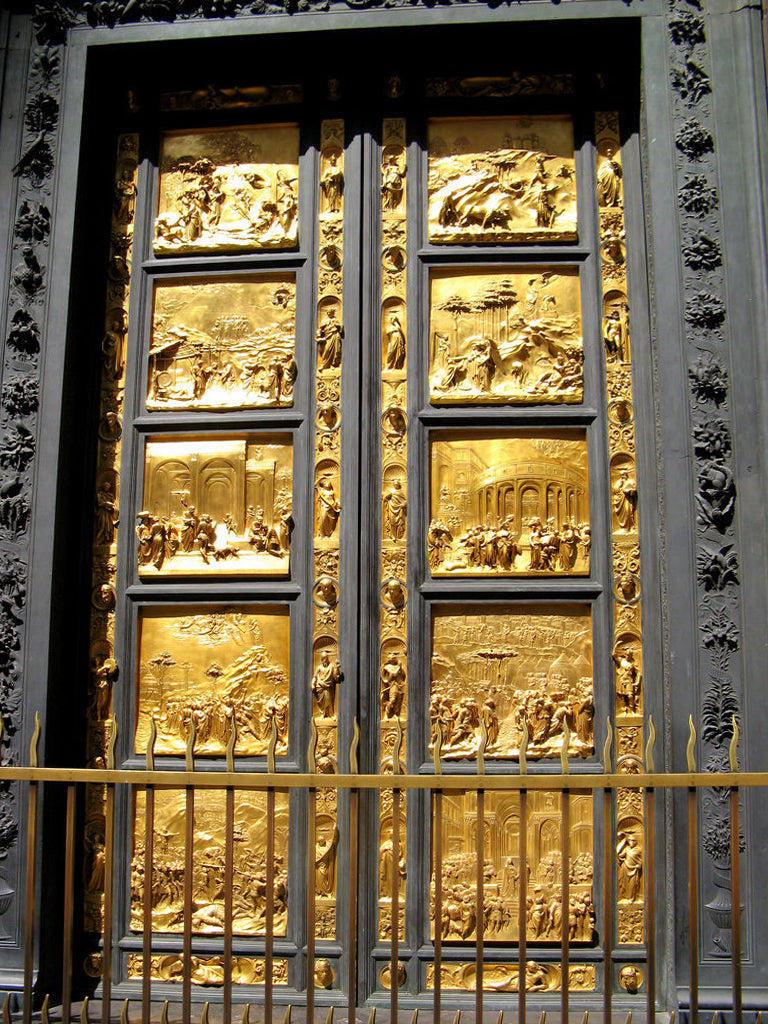
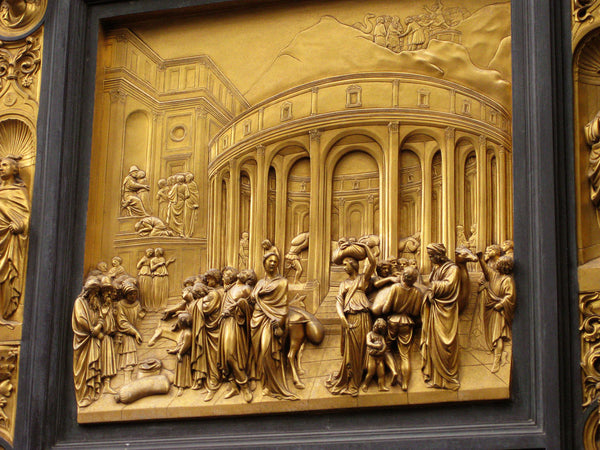
The workmanship of the panels, mastering linear perspective and striking beauty is awe-inspiring. I believe it was because of these doors, that the tradition and noble craftsmanship of hand painting and carving wood doors in Italy began.
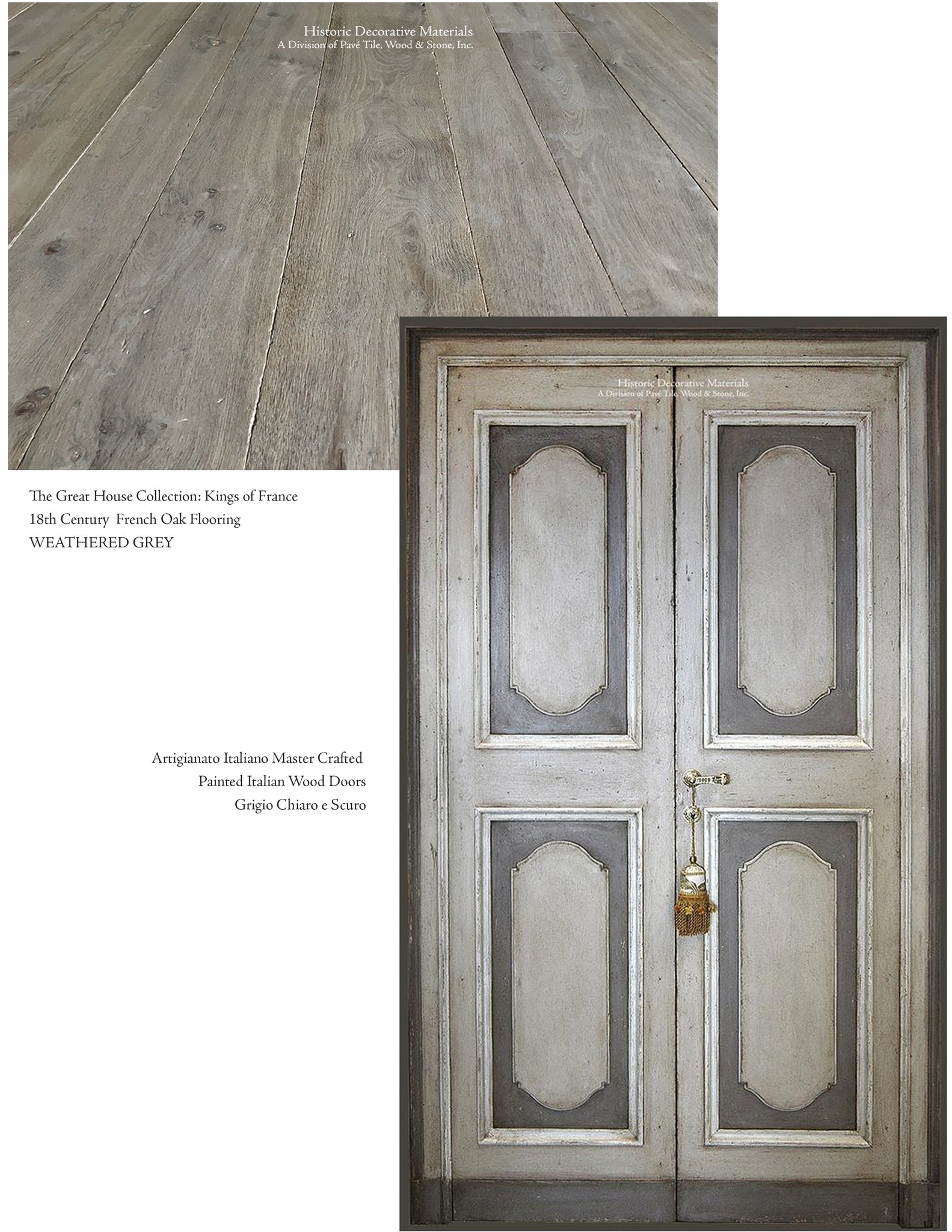
During this influential time period in Italy, a Venetian Architect, Andrea Palladio, began constructing buildings and homes from the formal classical temple architecture of the Ancient Greeks and Romans defined by symmetry, perspective and simple beauty. This type of architecture - now known as the Palladian Style disseminated throughout Europe and became extremely popular during the mid-17th century Britain. It is of no surprise then, as the British Colonists began establishing their lives on the Eastern Shores of North America - their love of Palladian Architecture traveled with them. This leads me to Drayton Hall.
Drayton Hall is an outstanding example of Palladian architecture and the only home on the Ashley River near Charleston, South Carolina, to survive intact through both the Revolutionary and Civil wars. As you observe the images below, keep in mind this following fact: you are observing what is essentially a mash-up of Classical Greek and Roman Architecture blended with Italian Renaissance Art and Palladian Design, tweaked and transformed to fit the demure cultural aesthetics of the British colonists...who have colonized North American shores and are now Americans. Notice the doors in image 2 - their paneling and colors - as Americana as one would believe...or so you thought!

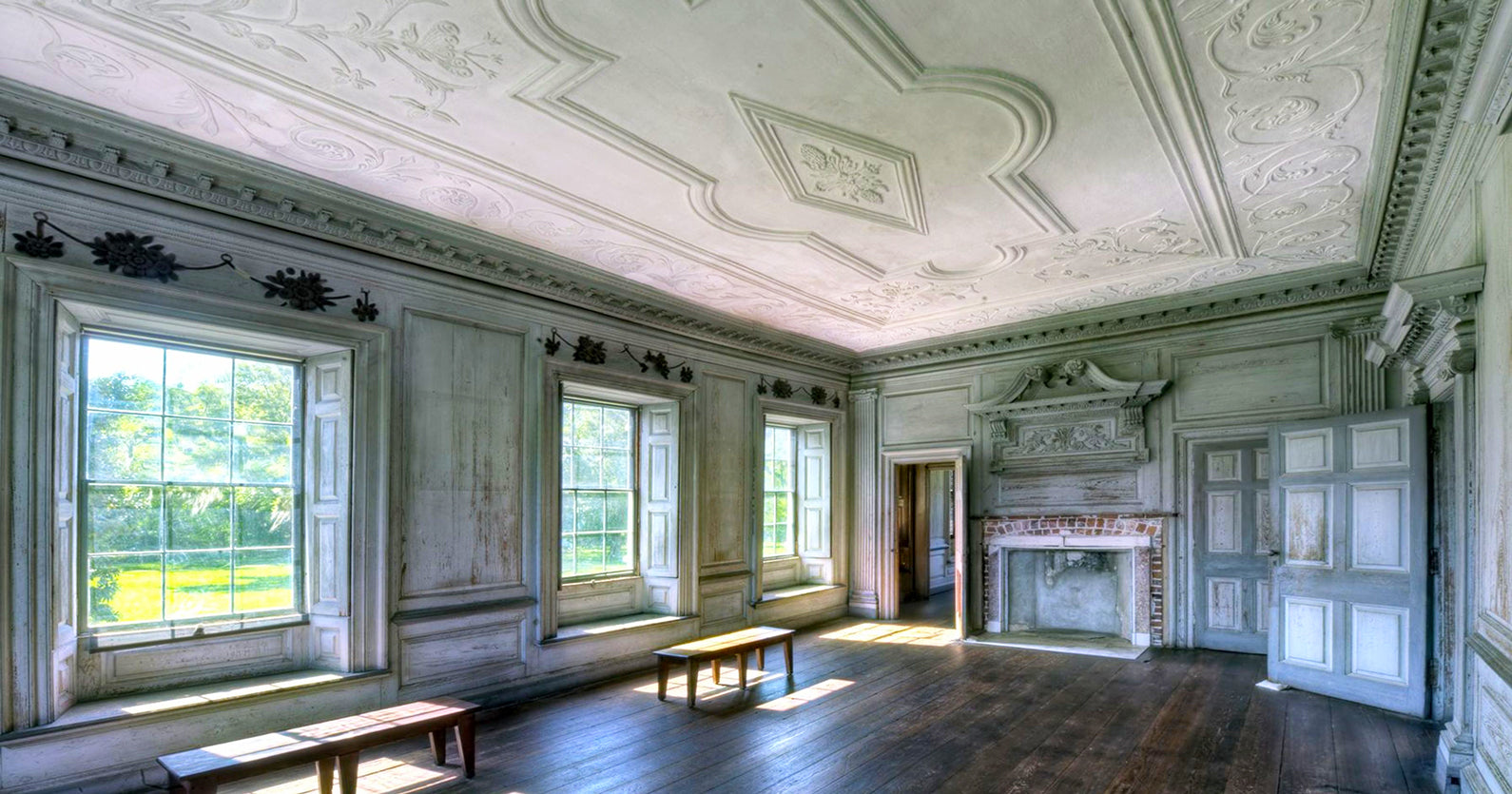
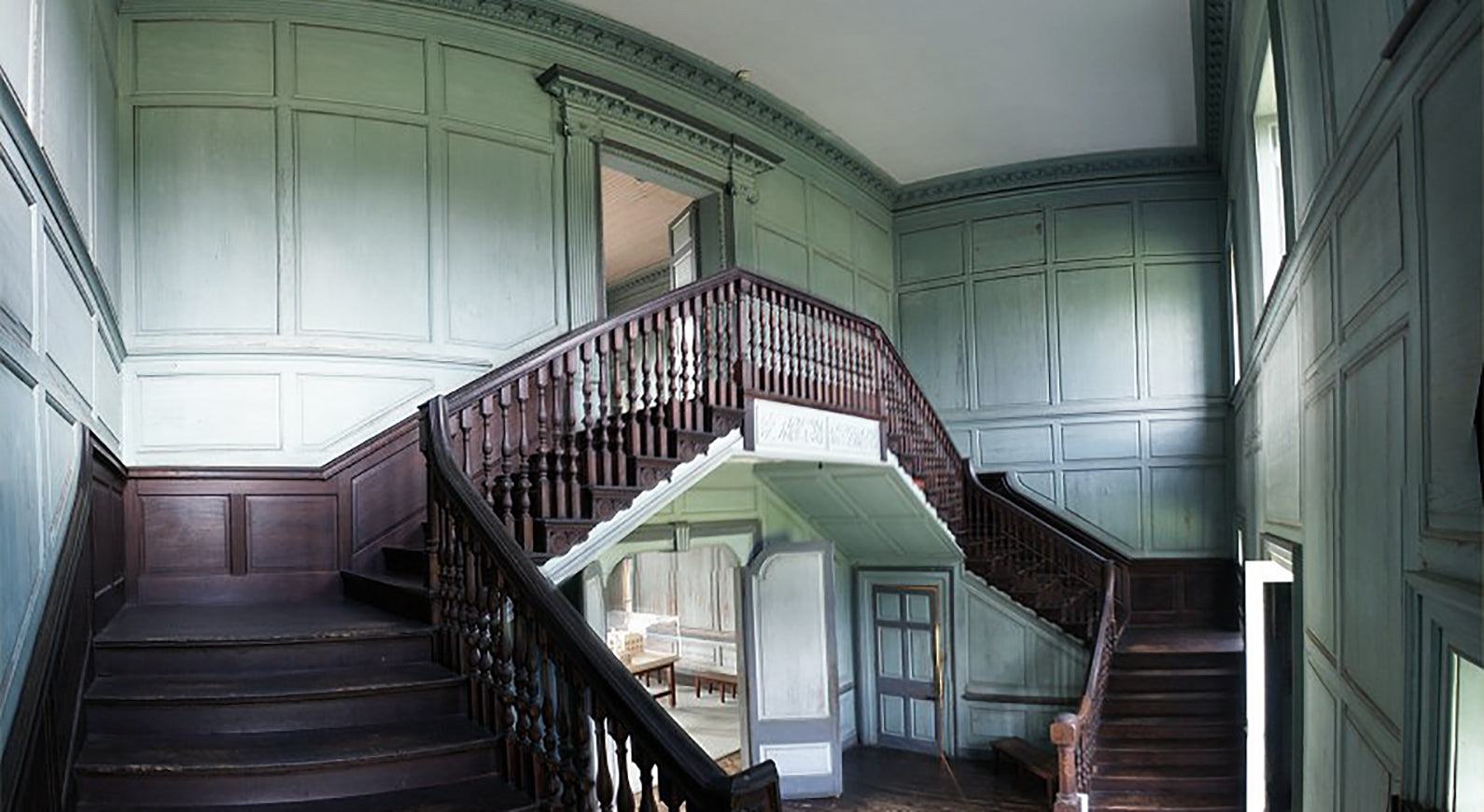
For purists or for those who are classically trained designers and architects - by definition - know our love for American art and design, architecture and history have always been an eclectic interior. Today - we seem to be drawn to minimalism +. It is my thought with the chaos of today's world, seeking sanctuary and reprieve in our homes is an innate need for our mental health. The ever popular mash-up of Minimalism + Farmhouse interiors is still well-loved, as it should be. Axel Vervoordt adds to this by combining Minimalist + Classical interiors at times in his interiors - which is appealing to many as well. This combination brings forward an elegance while still retaining a sense of quiet and tranquility.
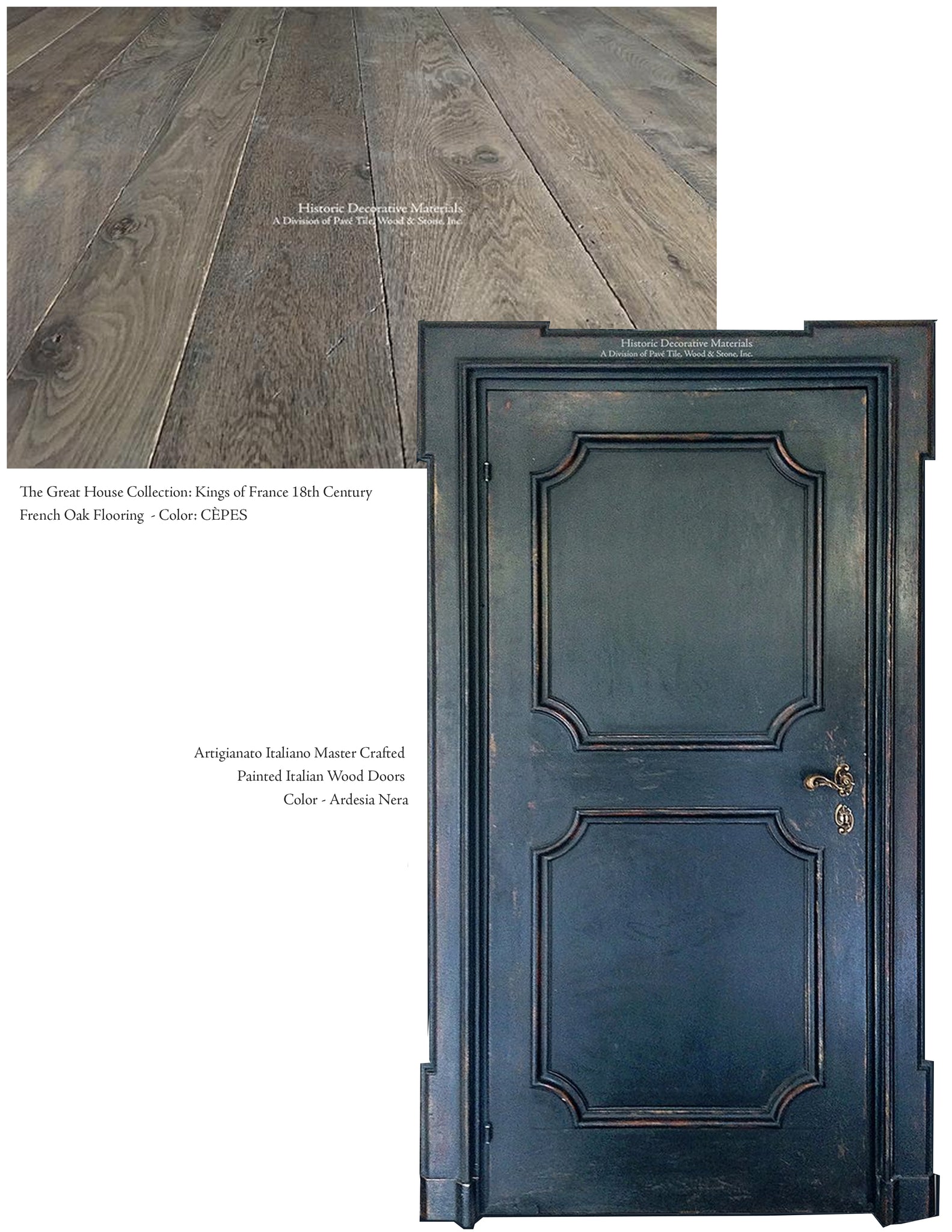 Finding the right door for your interiors takes thoughtfulness - but more than that - it takes an understanding of knowing what you like. That may sound difficult - you may like so many ideas that your Pinterest boards are packed to the brim. I always ask my clients - what does your instinct say? Forget what I think, what the neighbors think, what your mom thinks - how do you feel? I want to feel uplifted in my home while grounded with elegant beauty at the same time. Perhaps this is why minimalist + classical interiors speak to me. What is essential about our Italian Doors is that they are bespoke. From the Farrow & Ball Coulour Palette - one can choose subtle tone-on-tone colors to bold contrasts. One can choose as little ornate paneling as possible or nearly Baroque. What I do know is that a hand painted door in the right color will not compete with an already chosen wood floor. I like to mix interior design styles - not different colors of wood tones.
Finding the right door for your interiors takes thoughtfulness - but more than that - it takes an understanding of knowing what you like. That may sound difficult - you may like so many ideas that your Pinterest boards are packed to the brim. I always ask my clients - what does your instinct say? Forget what I think, what the neighbors think, what your mom thinks - how do you feel? I want to feel uplifted in my home while grounded with elegant beauty at the same time. Perhaps this is why minimalist + classical interiors speak to me. What is essential about our Italian Doors is that they are bespoke. From the Farrow & Ball Coulour Palette - one can choose subtle tone-on-tone colors to bold contrasts. One can choose as little ornate paneling as possible or nearly Baroque. What I do know is that a hand painted door in the right color will not compete with an already chosen wood floor. I like to mix interior design styles - not different colors of wood tones.
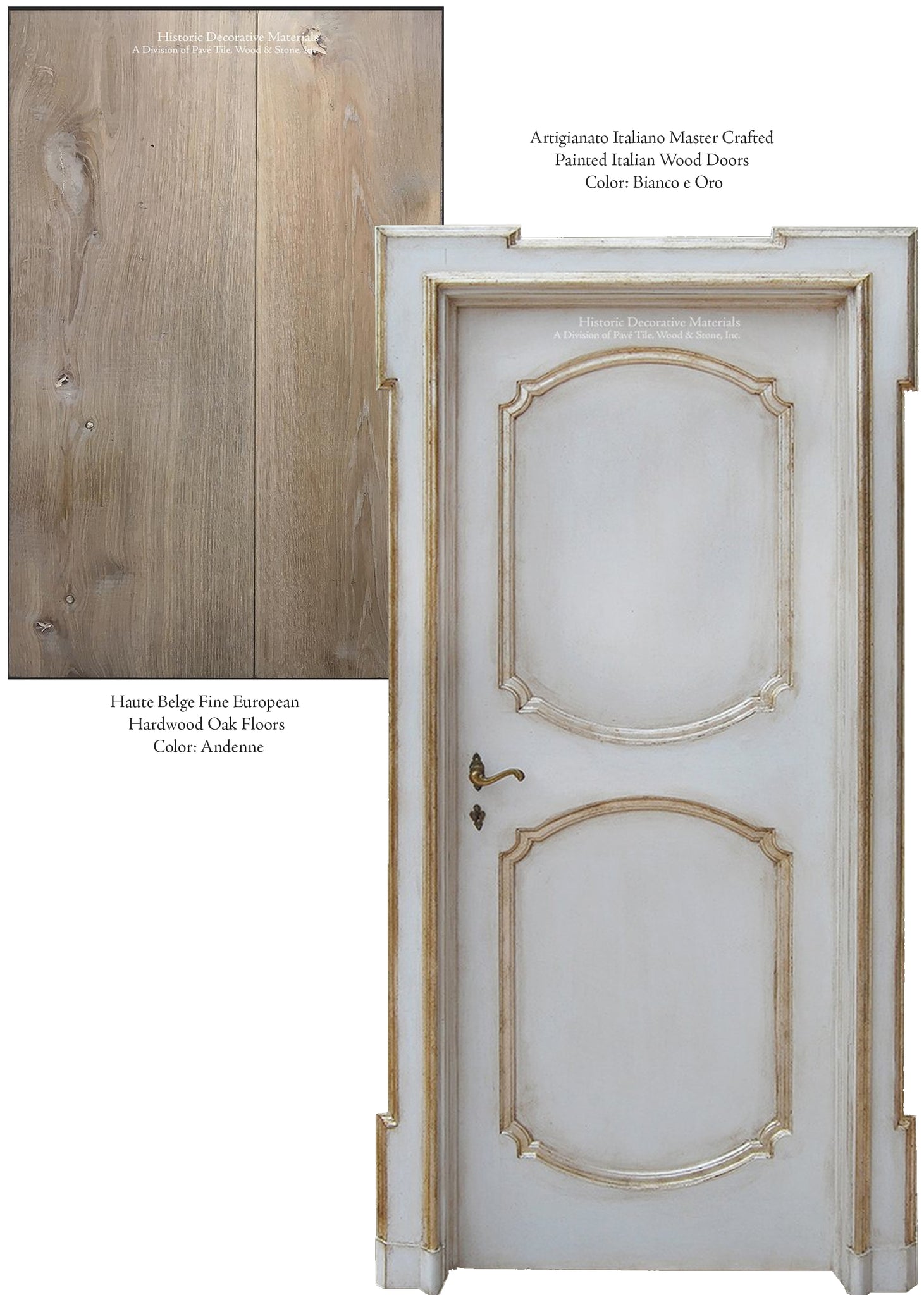
In this last image below, I paired our Kings of France Parquet de Versailles French Oak Floor with our Master Crafted Painted Italian Wood Door in color grigio blu. This does step away from minimalism - the artistry of the reclaimed inspired parquet floor is apparent and noble - but the parquet is a Classical Renaissance detail. However - the beauty of the door + floor is inspiring and in today's interiors whether you choose minimalism + farmhouse or classical or minimal minimalism...the freedom is yours to choose.
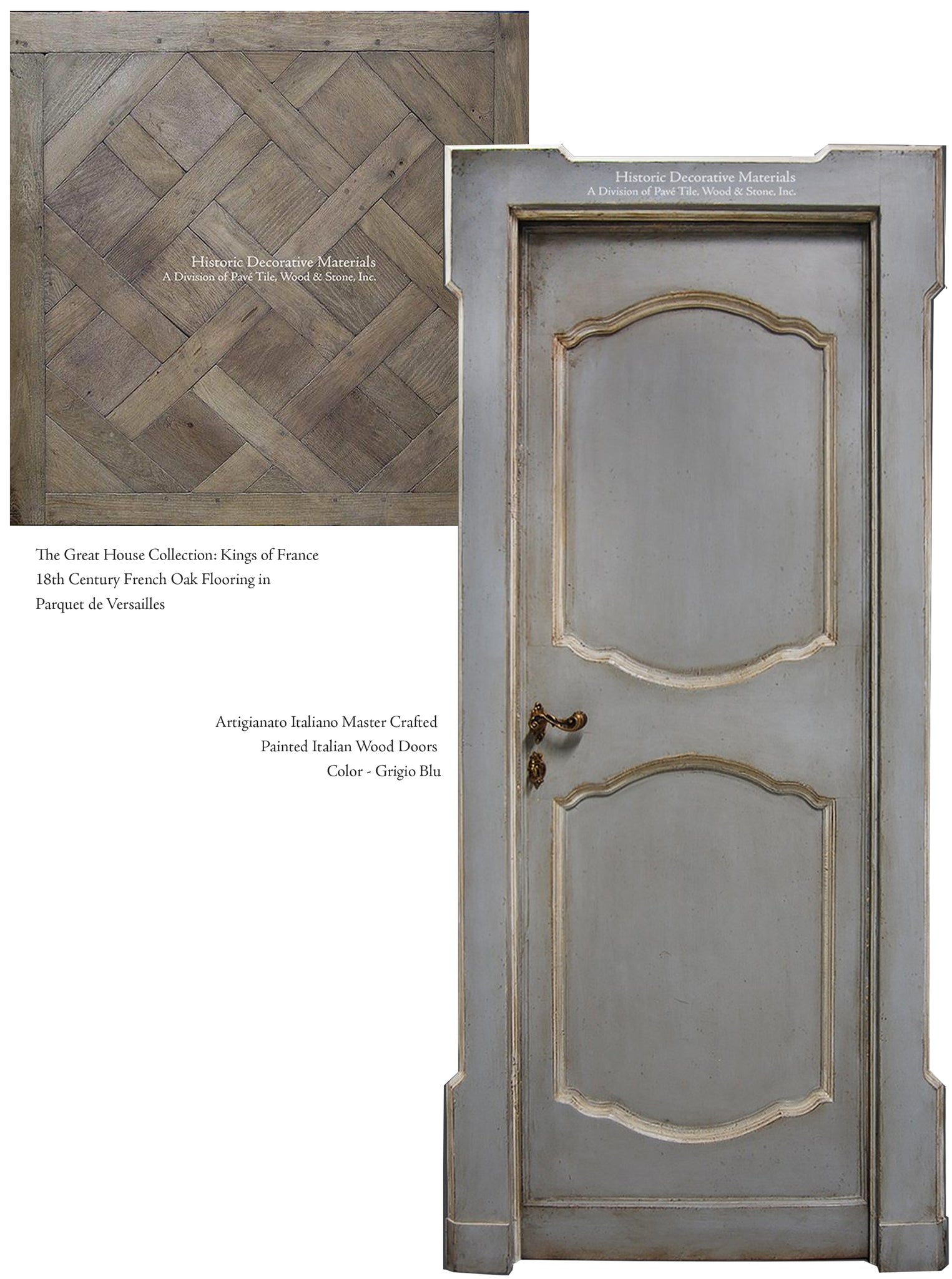
I hope this blog not only reveals a brief understanding from where design originates - but opens an internal dialogue to help you formally understand why you want something in your home. François and I take seriously our curated collections of materials and it is no small task to source and bring these materials into our showroom. Stepping away - far away - from large scale offerings that are easier to procure - we cultivate art and design for those who are searching for surfaces that elevate homes. If you would like to make an appointment at Pavé to view our collections and for a design appointment, please click here.
Thank you for your time,
Emmi Micallef
Comments will be approved before showing up.
August 07, 2025 1 Comment
Reminiscing on my love for Delft tile brought me back to childhood, while I visited Amsterdam this past summer with my family. Historically undeniable, antique Delft tiles have graced rooms from the grandest châteaux to the most humble farmhouses - always with 17th century charm of idyllic Amsterdam. Rethink that ubiquitous white subway tile - and give art and history a chance in your home installing antique Delft tiles.
June 28, 2025 4 Comments
Why is there a showroom in Western Massachusetts that is a small empire of stock for French and Belgian antique French oak and French limestone flooring? Read our origin story and learn how the quiet countryside of Western MA become a mecca for authentic, antique, European building materials.
March 05, 2025 1 Comment
Antique French limestone flooring, salvaged from old French structures, will have a patina and beauty that allow the interior designer, architect and homeowner to achieve a variety of interiors. From French country and Provence style to elegant manor homes, the beauty of historic French limestone floors is a timeless building material, that will add value and authenticity to a décor.
